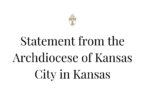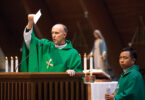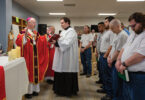by Carolyn Kaberline
LAWRENCE — Although many of the news stories coming from the Middle East tell of the persecution of Christians by Muslims, that’s not true in Oman.
In fact, Oman native Melanie D’Souza, a second-year architecture student at the University of Kansas, believes it’s easier being a Catholic in her native country than it is being a Catholic at KU!
“Although Oman is a 100-percent Islamic country like any other Arab country, there is what I call — not just tolerance — but appreciation of other religions,” said D’Souza, adding that the Catholics in Oman are predominantly expatriates from India, the Philippines, Sri Lanka, Pakistan, Egypt, France and elsewhere.
“While at KU, I feel like I am constantly judged for being Catholic,” she said. “People automatically assume that I am extremely conservative for reasons I fail to understand.”
Despite this, D’Souza said she has found a home at the St. Lawrence Catholic Student Center, especially among the resident Apostles of the Interior Life.
“I am also a regular parishioner of St. John the Evangelist Catholic Church, where I help out with confirmation students and occasionally lector,” said D’Souza. “In Oman, I was part of an extremely huge and close-knit Catholic community. My family was, and still is, involved with MIPC, or Mary Immaculate Prayer Community — a Marian prayer group that has really helped my foundation as a Catholic believer.”
In addition, D’Souza describes her parents’ education in the convents of Mumbai as very formative, since she and her younger sister attended secular public schools in their hometown of Muscat.
The MIPC, too, said D’Souza, had a great impact on her family’s life.
“For the longest time, many families there — mine included — were just regular Catholics,” D’Souza explained. “We attended Sunday Mass and that was it. That was all we ever did Catholic. Of course, we occasionally prayed the rosary and had Catholic votive pieces in the house and attended feast days of holy obligation, but that was it.”
That all changed, however, through the MIPC, which had prayer meetings every week.
“We learned many things,” she said, “from being educated on what differentiates us as Catholics from other Christians [and] the Catholic ideals we stand for, to learning about various Christian artists and using their songs for praise and worship.”
D’Souza says MIPC members prayed together and enjoyed a strong bond of fellowship and witness.
“It taught my family that attending Mass wasn’t the only part of the Catholic package,” she said.
That sense of duty to the church has carried over into D’Souza’s time in Lawrence. Not only does she help with the confirmation classes at St. John’s, but she also writes to her peers — teenagers and young adults — about her own journey in the Catholic faith.
“I wrote my first article on . . . the sacrament of reconciliation, and it was published in The Oasis, the MIPC quarterly,” said D’Souza. “It was well-received, and my elders in the community encouraged me to write more.”
Since then, her articles have been published in Charisindia, the official newsletter for the National Charismatic Office of India; the Examiner, the national Catholic newsletter of India; and the Madonna, a monthly publication of the Salesians of the Shrine of Don Bosco in Mumbai.
Although D’Souza has at least four more years in Lawrence as she pursues a degree in architecture, she says she is often asked about her future plans.
“I am only 18. And at this point, it seems like a difficult decision to make,” she said. “I would love to eventually become a licensed architect in the state of Kansas and work for a Kansas City architect firm, but my dream is to one day restore churches in Portugal. Of course, before that, I’d love to design simple homes and plan city layouts for Muscat and Mumbai. There are many options.”
Her interest in Portuguese churches stems from her cultural background.
“Both of my parents are Goan,” she says. “Goans are from a small Indian state called Goa very close to Mumbai. It was a Portuguese colony for 400 years up until as late as 1961. The Portuguese brought Catholicism to this region during colonization. Our culture — Goan culture — [still] today has a heavy Portuguese influence.”
That influence, she says, can be found in the cuisine, the folk culture, the religion, the fashions and many other facets of daily life. Because of her background, D’Souza lists her favorite role model as Goan architect Charles Correa, who pioneered the Modernist architecture movement in South Asia and Lisbon and is the reason she would also one day like to live in Portugal.
Regardless of where her career takes her after she leaves KU, she knows that evangelization will be a big part of her future — whether it be through writing, working with youth, or some other way.
“Oman and Kansas are both places of Catholic minority but, in my opinion, store much potential for developing the faith into more homes, more families,” she said. “It is wonderful to see how Oman, falling under the Apostolic Vicariate of Arabia, and the United States Conference of Catholic Bishops can be connected, and I’d like to be that connection.”
“That is the power of the Catholic Church,” she continued.
Worldwide, parishioners are connected with a wide Vatican canopy through the strong leadership of Pope Francis that resonates through able archbishops, bishops, priests, deacons, religious Brothers and Sisters and catechists.
“It is great to be part of this universal family,” she added. “And that’s literally what Catholic means — universal.”






